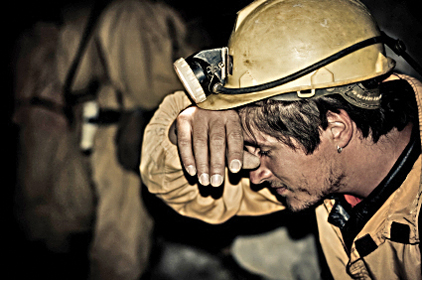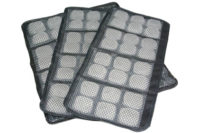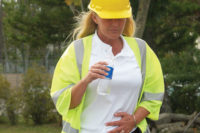The effects of heat stress range from simple discomfort to life-threatening illnesses such as heat stroke. Aside from the environmental factors (such as temperature, humidity, air movement, and radiant heat), the person’s work regimen and clothing requirements are also factors that determine the risk of heat strain.
A 2010 Technical Report on Occupational Heat Illness on 483 claims from the State of Washington found that:
- The average cost of the heat-related illness claims was $3,682 which was well below the average cost of a state fund claim of $8,510.
- Industry sectors accounting for the most number of claims were Construction — 142 claims (29.4 percent), and Public Administration — 102 claims (21.1 percent). In all but Manufacturing and Food Accommodation industry sectors, the majority of claims occurred from exposure to heat in an outdoor environment.
- Over 97 percent (383) of the outdoor heat-related injury claims occurred from May to September.
- The median maximum temperature for the business location of the employer for all outdoor heat-related injury claims was 89°F.
According to the U.S. Department of Labor Bureau of Labor Statistics (BLS), from 2003 – 2008, there were 177 deaths1 and 13,580 cases with days away from work2 due to ‘Exposure to Environmental Heat’ in the private sector workforce.
Monitoring makes a difference
To ensure that employees are provided with the most cutting-edge safety equipment, significant research has been conducted into the way in which heat stress monitors can be used to counteract and prevent the very serious and potentially fatal results of heat stroke. Fortunately, as a result of the research conducted in this area, an array of effective heat stress monitors is available today.
Heat stress prevention begins with worker training, acclimation, and environmental monitoring. Many kinds of devices have been introduced over the years.
Technology evolves
In the beginning we only monitored ambient temperature using Thermometers but soon found that humidity had an effect on the body’s natural ability to cool.
Temperature and Humidity Meters came to pass but did not provide a complete answer. The influences of radiant heat, air flow, work rate and clothing ensembles are not considered by temperature and humidity measurements alone. Each of these additional factors can greatly influence an individual’s physiological tolerance of heat.
WBGT (Wet-Bulb Globe Temperature) Monitors were introduced many years ago to simplify environmental measurements for heat stress and are considered by many experts to still be the gold standard for heat stress monitoring. These portable instruments calculate a WBGT Index value that considers the effects of ambient air temperature, humidity, air flow (which provides an evaporative cooling effect to the body) and radiant heat from sources such as the sun, furnaces, ovens, boilers, etc.
The measured WBGT Index is applied to look-up tables from organizations like the U.S. Navy, the American Conference of Governmental Industrial Hygienists, the Electric Power Research Institute, ISO and others to determine safe work times or appropriate work-rest regimens within the monitored environment. In more recent years, clothing ensembles have been recognized as creating micro-environments for the worker and much research has been completed to expand the look-up tables to include stay times and work-rest regimens based on various clothing types and work rates. The more advanced WBGT monitors of today have incorporated these look-up tables into the firmware of the instrument. The meter is then able to determine and display stay times or work-rest regimens for immediate application to the work at hand.
Stationary Ambient Heat Stress Monitoring Systems are a very modern introduction for facilities where environmental conditions and workload can combine to create heat stress hazards. The stationary system performs continuous surveillance of a facility and provides designated personnel with the real-time information they need to promptly and effectively intervene in order to avoid or minimize heat stress injuries and illnesses. Continuous real-time surveillance is most important wherever environmental conditions or personnel may change throughout the day, week, month or season. Networked stationary systems allow application of the management-by-exception principle to heat stress prevention. This simply means that the system tracks and reviews environmental conditions but does not initiate intervention unless action is necessary per user-defined specifications.
Personal Heat Stress Monitors and Self Alert Sensors were introduced in recognition that physiological responses to heat stress can vary widely from person to person. More physically fit workers may tolerate heat better than less physically fit workers. Workers accustomed to the environment may tolerate heat better than those unaccustomed to the hot environment or work load. Persons taking prescription or over-the-counter drugs may also be less tolerant of heat than when they are not taking these drugs. In these situations, personal monitors provide an additional level of protection by directly detecting the individual’s physiological response. Core temperature or correlated core temperature is a commonly monitored vital sign. Alarms activate when this vital sign rises beyond user or factory defined set points.
Heat stress management
All of these systems will help to identify a potential problem. No one method is best for all applications and oftentimes some combination of these monitoring methods is most appropriate. Once you have identified the problem, make sure to provide the necessary rehab items for the affected employee: rest, hydration, shade, cooling fans, cooling stations, or active cooling systems. Consult with an organization with extensive experience in heat stress monitoring and management. Such a company can leverage experience across a broad array of applications to help develop the best overall strategy for heat stress monitoring and heat illness prevention.
References
1 Bureau of Labor Statistics. The National Census of Fatal Occupational Injury, 2009. US Department of Labor, Washington, D.C. Available at http://www.bls.gov/iif/oshwc/cfoi/cftb0204.pdf.
2 Bureau of Labor Statistics. Survey of Occupational Injury and Illness, 2009. US Department of Labor, Washington, D.C. Available at http://www.bls.gov/iif/oshwc/osh/case/ostb1574.pdf.



